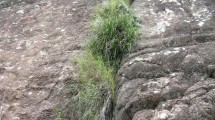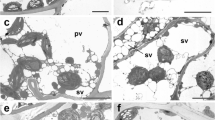Abstract
The mechanisms of protection against mechanical and oxidative stress were identified and compared in the angiosperm resurrection plants Craterostigma wilmsii, Myrothamnus flabellifolius and Xerophyta humilis. Drying-induced ultrastructural changes within mesophyll cells were followed to gain an understanding of the mechanisms of mechanical stabilisation. In all three species, water filled vacuoles present in hydrated cells were replaced by several smaller vacuoles filled with non-aqueous substances. In X. humilis, these occupied a large proportion of the cytoplasm, preventing plasmalemma withdrawal and cell wall collapse. In C. wilmsii, vacuoles were small but extensive cell wall folding occurred to prevent plasmalemma withdrawal. In M. flabellifolius, some degree of vacuolation and wall folding occurred, but neither were sufficient to prevent plasmalemma withdrawal. This membrane was not ruptured, possibly due to membrane repair at plasmodesmata junctions where tearing might have occurred. In addition, the extra-cytoplasmic compartment appeared to contain material (possibly similar to that in vacuoles) which could facilitate stabilisation of dry cells.
Photosynthesis and respiration are particularly susceptible to oxidative stress during drying. Photosynthesis ceased at high water contents and it is proposed that a controlled shut down of this metabolism occurred in order to minimise the potential for photo-oxidation. The mechanisms whereby this was achieved varied among the species. In X. humilis, chlorophyll was degraded and thylakoid membranes dismantled during drying. In both C. wilmsii and M. flabellifolius, chlorophyll was retained, but photosynthesis was stopped due to chlorophyll shading from leaf folding and anthocyanin accumulation. Furthermore, in M. flabellifolius thylakoid membranes became unstacked during drying. All species continued respiration during drying to 10% relative water content, which is proposed to be necessary for energy to establish protection mechanisms. Activity of antioxidant enzymes increased during drying and remained high at low water contents in all species, ameliorating free radical damage from both photosynthesis and respiration. The nature and extent of antioxidant upregulation varied among the species. In C. wilmsii, only ascorbate peroxidise activity increased, but in M. flabellifolius and X. humilis ascorbate peroxidise, glutathione reductase and superoxide dismutase activity increased, to various extents, during drying. Anthocyanins accumulated in all species but this was more extensive in the homoiochlorophyllous types, possibly for protection against photo-oxidation.
Similar content being viewed by others
References
Altus, D. P. & Hallam, N. D. 1980. Fine structure of hydrated and air-dry leaves of Sporobulus stapfianus gandoger, a drought tolerant grass. Micron 11: 515–516.
Berjak, P., Pammenter, N. W. & Vertucci, CW. 1992. Homoiohydrous (recalcitrant) seeds: developmental status, desiccation sensitivity and the state of water in axes of Landolphia kirkii Dyer. Planta 186: 249–261.
Berjak, P. & Pammenter, N. W. 1999. A review of recalcitrant seed physiology in relation to desiccation-tolerance mechanisms. Seed Sci. Res. 9: 13–37.
Bewley, J. D. & Krochko, J. E. 1982. Desiccation-tolerance. Pp. 325–378. In: Lange O. L., Nobel, P. S., Osmond, C. B. & Ziegler H. (eds), Encyclopaedia of plant physiology. Vol. 12 B, Physiological Ecology II. Springer-Verlag, Berlin.
Bewley, J. D. & Black, M. 1994. Seeds. Physiology of development and germination. Plenum Press, New York.
Bianchi, G., Gamba, A., Murelli, C., Salamini, F. & Bartels, D. 1991. Novel carbohydrate metabolism in the resurrection plant Craterostigma plantigineum. Plant J. 1: 355–359.
Bianchi, G., Gamba, A., Limiroli, R., Pozzi, N., Elster, R., Salamini, F. & Bartels D. 1993. The unusual sugar composition in leaves of the resurrection plant Myrothamnus flabellifolius. Physiol. Plant. 87: 223–226.
Crowe, J. H., Hoekstra, F. A. & Crowe, L. M. 1992. Anhydrobiosis. Annu. Rev. Physiol. 54: 579–599.
Dalla Vecchia, F., El Asmar, T., Calamassi, R., Rascio, N. & Vazzana, C. 1998. Morphological and ultrastructural aspects of dehydration and rehydration in leaves of Sporobolus stapfianus. Plant Growth Regul. 24: 219–228.
Dure, L. III. 1993. A repeating 11-mer amino acid motif and plant desiccation. Plant J. 3: 363–369.
Elstner, E. F. & Heipel, A. 1976. Inhibition of nitrite formation from hydroxyl ammonium chloride: a simple assay for superoxide dismutase. Anal. Biochem. 70: 616–620.
Farrant, J. M., Cooper, K., Kruger, L. A. & Sherwin, H. W. 1999. The effect of drying rate on the survival of three desiccationtolerant angiosperm species. Ann. Bot. 84: 371–379.
Farrant, J. M. & Sherwin, H. W. 1998. Mechanisms of desiccation tolerance in seeds and resurrection plants. Pp. 109–120. In: Taylor, A. G. & Huang X-L (eds), Progress in seed science research. Communication Services of the New York State Agricultural Experimental Station, Geneva, New York.
Gaff, D. F. 1971. Desiccation tolerant flowering plants in Southern Africa. Science 174: 1033–1034.
Gaff, D. F. 1989. Responses of desiccation tolerant "resurrection" plants to water stress. Pp. 264–311. In: Kreeb, K. H., Richter, H. & Hinckley, T. M. (eds), Structural and functional responses to environmental stresses: water shortages. SPB Academic Publishing, The Hague, Netherlands.
Ghasempour, H. R., Gaff, K. F., Williams, R. P. W. & Gianello, R. D. 1998. Contents of sugars in leaves of drying desiccation tolerant flowering plants, particularly grasses. Plant Growth Regul. 24: 185–191.
Goldsworthy, D, & Drennan, P. M. 1991. Anhydrous fixation of desiccated leaves of Myrothamnus flabellifolia Welw. Electron Microsc. Soc. South Africa 21: 105–106.
Halliwell, B. 1987. Oxidative damage, lipid peroxidation and antioxidant protection in chloroplasts. Chem. Phys. Lipids 44: 327–340.
Hendry, G. A. F. 1993. Oxygen, free radical processes and seed longevity. Seed Sci. Res. 3: 141–153.
Hetherington, S. E., Hallam, N. D. & Smillie, R. M. 1982. ultrastructure and compositional changes in chloroplast thylakoids of leaves of Borya nitida during humidity-sensitive degreening. Aust. J. Plant Physiol. 9: 601–609.
Iljin, W. S. 1957. Drought resistance in plants and physiological processes. Annu. Rev. Plant Physiol. 3: 341–363
Ingram, J. & Bartels, D. 1996. The molecular basis of dehydration tolerance in plants. Annu. Rev. Plant Physiol. Plant Molec. Biol. 47: 377–403.
Kaiser, W. M. 1987. Effects of water deficit on photosynthetic capacity. Physiol. Plant. 71: 142–149.
Koonjul, P., Brandt, W. F., Lindsey, G. G. & Farrant, J. M. 2000. Isolation and characterisation of chloroplasts from Myrothamnus flabellifolius Welw. J. Plant Physiol. 156: 584–594.
Kranner, I. & Grill, D. 1997. Desiccation and the subsequent recovery of cryptogamics that are resistant to drought. Phyton 37: 139–150.
Larson, A. 1988. The antioxidants of higher plants. Phytochemistry 27: 969–978.
Leopold, A. C. & Vertucci, C. W. 1986. Physical attributes of desiccated seeds. Pp. 22–34. In: Leopold, A. C. (ed.), Membranes, metabolism and dry organisms. Cornell University Press, Ithaca.
Leopold, A. C., Bruni, F. & Williams, R. J. 1992. Water in dry organisms. Pp. 161–169. In: Somero, G. N., Osmond, C. B. & Bolis, C. L. (eds), Water and Life. Comparative analysis of water relationships at the organismic, cellular and molecular levels. Springer-Verlag, Berlin.
Levitt, J.1980. Responses of plants to environmental stresses. Vol. 2. Water, radiation, salt and other stresses. Academic Press, New York.
Lichtenthaler, H. K. 1987. Chlorophylls and carotenoids, the pigments of the photosynthetic biomembranes. Methods Enzymol. 148: 350–382.
Mancinelli, A. L., Yang, C-PH, Lindquist, P., Anderson, O. R. & Rabino, I. 1975. Photocontrol of anthocyanin synthesis III. The action of streptomycin on the synthesis of chlorophyll and anthocyanin. Plant Physiol. 55: 251–257.
McCord, J. M. & Fridovich, I.1969. Superoxide dismutase and enzymatic function for erythrocuprein (hemocuprein). J. Biol. Chem. 244: 6049–6055.
Navari-Izzo, F., Meneguzzo, S., Loggini, B., Vazzana, C. & Sgherri, C. L. M. 1997a. The role of glutathione system during dehydration of Boea hygroscopica. Physiol. Plant. 99: 23–30.
Navari-Izzo, F., Quartacci, M. F. & Sgherri, C. L. M. 1997b. Desiccation tolerance in higher plants related to free radical defences. Phyton 37: 203–214.
Oliver, M. J. & Bewley, J. D. 1997. Desiccation tolerance of plant tissues: a mechanistic overview. Horticult. Rev. 18: 171–213.
Oliver, M. J., Wood, A. J. & O'Mahony, P. 1998. To dryness and beyond-preparation for the dried state and rehydration in vegetative desiccation-tolerant plants. Plant Growth Regul. 24: 193–201.
Reynolds, E. S. 1963. The use of lead citrate ah high pH as an electron opaque stain for electron microscopy. J. Cell Biol. 17: 208–212.
Schneider, K., Wells, B., Schmelzer, E., Salamini, F. & Bartels, D. R. 1993. Desiccation leads to the rapid accumulation of both cytosolic and chloroplastic proteins in the resurrection plant Craterostigma plantagineum Hoscht. Planta 189: 120–131.
Sgherri, C. L. M., Loggini, B., Bochicchio, A. & Navari-Izzo, F. 1994a. Antioxidant system in Boea hydroscopica: changes in response to rapid or slow desiccation and rehydration. Phytochemistry 37: 377–381.
Sgherri, C. L.M., Loggini, B., Puliga, S. & Navi-Izzo, F. 1994b. Antioxidant system in Sporobolus stapfianus: changes in response to desiccation and rehydration. Phytochemistry 35: 561–565.
Sherwin, H. W. 1995. Desiccation tolerance and sensitivity of vegetative plant tissue. PhD thesis, University of Natal, Durban, South Africa.
Sherwin, H. W. & Farrant, J. M. 1996. Differences in rehydration of three desiccation-tolerant angiosperm species. Ann. Bot. 78: 703–710.
Sherwin, H. W. & Farrant, J. M. 1998. Protection mechanisms against excess light in three resurrection plants Craterostigma wilmsii and Xerophyta viscosa. Plant Growth Regul. 24: 203–210.
Smirnoff, N. 1993. The role of active oxygen in the response of plants to water deficit and desiccation. New Phytol. 125: 27–58.
Spurr, A. R. 1969. A low viscosity epoxy resin embedding medium for electron microscopy. J. Ultrastructural Res. 26: 31–43.
Tuba, Z., Lichtenthaler, H. K., Csintalan, Zs., Nagy, Z. & Szente, K. 1996. Loss of chlorophylls, cessation of photosynthetic CO2 assimilation and respiration in the poikilochlorophyllous plant Xerophyta scabrida. Physiol. Plant. 96: 383–388.
Tuba, Z., Smirnoff, N., Csintalan, Zs., Szente, K. & Nagy, Z.1997. Respiration during slow desiccation of the poikilochlorophyllous desiccation tolerant plant Xerophyta scabrida at present day CO2 concentration. Plant Physiol. Biochem. 35: 381–386.
Tuba, Z., Proctor, M. C. F. & Csintalan, Zs. 1998. Ecophysiological responses of homoiochlorophyllous and poikilochlorophyllous desiccation tolerant plants: a comparison and ecological perspective. Plant Growth Regul. 24: 211–217.
Vertucci, C. W. & Farrant, J. M. 1995. Acquisition and loss of desiccation tolerance. Pp. 237–271. In: Kigel, J. & Galilli, G. (eds), Seed development and Germination. Marcel Dekker, Inc., New York.
Vicre, M., Sherwin, H. W., Driouich, A., Jaffer, M. A. & Farrant, J. M. 1999. Cell wall characteristics and structure of hydrated and dry leaves of the resurrection plant Craterostigma wilmsii, a microscopical study. J. Plant Physiol. (in press).
von Caemmerer, S. & Farquhar, G. D. 1981. Some relationships between the biochemistry of photosynthesis and the gas exchange of leaves. Planta 153: 376–387.
Wang, S. Y., Jiao, H. J. & Faust, M. 1991. Changes in ascorbate, glutathione and related enzyme activities during thidiazuroninduced bud break of apple. Physiol. Plant. 82: 231–236.
Author information
Authors and Affiliations
Rights and permissions
About this article
Cite this article
Farrant, J.M. A comparison of mechanisms of desiccation tolerance among three angiosperm resurrection plant species. Plant Ecology 151, 29–39 (2000). https://doi.org/10.1023/A:1026534305831
Issue Date:
DOI: https://doi.org/10.1023/A:1026534305831




